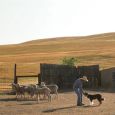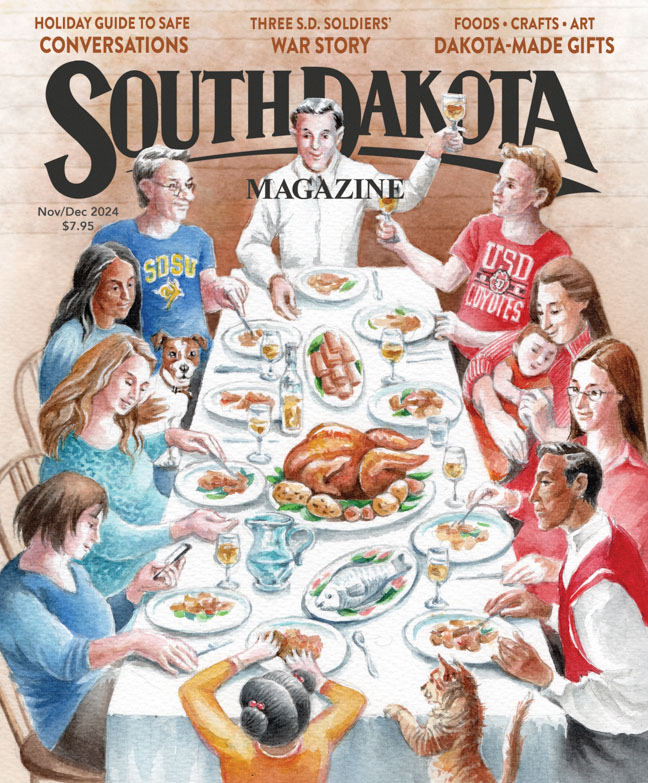The Gift of South Dakota
Subscriptions to South Dakota Magazine make great gifts!
Subscribe today — 1 year (6 issues) is just $29!
South Dakota: Superpower
Mar 28, 2017
 |
| The Minuteman Missile National Historic Site is a reminder of the weapons that dotted the West River landscape during the Cold War. |
I’m the product of a Cold War childhood. The realization hit me while visiting several Minuteman missile sites scattered around West River. All sorts of memories flooded my mind: duck and cover drills, grade school lectures about Communism, wishing my family had a bomb shelter — not because I feared attack but because entertaining friends in a bomb shelter sounded cool.
And then there was Ann, my neighbor and fourth grade classmate, blonde and remarkably long-armed. What I remember best about Ann is her smiling and kind face, which, for me, was the very face of the Cold War.
Let me explain. Ann’s family, like mine, lived in St. Paul in the early 1960s. My family moved there from Iowa while hers originally hailed from one of the Soviet states. With her long arms, she threw a baseball harder than any other kid I knew, not that she cared about the sport itself or could identify Killebrew from Khrushchev. But she played a good game of catch and her delivery turned my fingers purple through my mitt’s thick leather. I don’t recall her last name or, actually, her first. Ann was short for something she decided her American peers only mangled. Sometimes I saw her around the neighborhood with her father, so I recognized him one winter afternoon as he stepped into a barbershop where I waited my turn. Ann’s father and the barber started needling one another in friendly fashion, something that sounded like a regular routine between them. Americans, I recall Ann’s dad declaring, liked their candies too sweet and their beers too sparkly. And even Minnesotans had no idea what a real winter — a Russian winter — felt like.
“Soft,” he said. “I hate the Soviet government but I fear America is too soft to resist it. Especially Russian women are tough. They alone could defeat America.”
For a while that remark shaped my thinking of a potential U.S.-Soviet war. I imagined full-grown, strong-armed Anns marching out of the north, scoffing at the Minnesota winter, tossing grenades with tremendous force.
I first heard of the Cold War a couple years earlier when my family still lived in Iowa. From a dark field west of Indianola one night, in the company of several other families, we waited for a freshly launched American satellite to pass over. I think maybe I saw it, but there were lots of twinkling lights up there. The next day my second grade teacher explained why that satellite was important. If the United States fell behind Russia in space and elsewhere, she said, we would end up living under Communism. Many of my classmates were farm kids and this teacher hit a nerve when she defined Communism as a way of life where you might still live and work on a farm, but Mom and Dad wouldn’t own the farm or tractors or crops or livestock. (Though Communism never reached Iowa, I remembered her remarks decades later when I read about Iowa farm families going to work for corporate agricultural operations.)
Not long after we watched the satellite, my family moved to St. Paul, just in time for the Cuban missile crisis and duck-and-cover drills at school. When a drill began, each student was issued a laminated nametag. The lamination, we grade schoolers whispered in awed tones, was so the tags would survive and our charred bones could be identified after a Russian attack. No one hassled Ann about her heritage. She was one of us as she took her tag and ducked and covered out in the school hallway, under the coat racks.
It wasn’t until after my family moved to South Dakota, the very year many of the Minuteman missiles were being lowered into West River silos, that I learned the truth about a potential U.S.-Soviet hot war. There wouldn’t be any grenade-tossing Russian women but instead rockets delivering heat no laminated nametag could survive. And because there were 150 American missiles in western South Dakota each aimed at a Soviet target, we would be hit early. I’d be vaporized before my former St. Paul classmates lined up to duck and cover, and no one, Communist or free, would farm our radioactive fields for a long while.
Strangely, none of that troubled me. Mostly I just put it out of my head as I think most South Dakotans did. Or we joked about our state ranking among the top seven nuclear powers on earth, or took genuine patriotic pride in serving on the front line of an unusual war. And I knew people who adamantly believed living amid missiles was a small price to pay for the dependable, affordable electrical service their maintenance guaranteed. One thing for sure — maybe we liked our candies sweet and our beers sparkly, like other Americans. But living in western South Dakota, where nuclear warheads literally outnumbered towns, we never heard anyone say we weren’t tough.
Editor’s Note: This column is revised from the May/June 2007 issue of South Dakota Magazine. To order a copy or to subscribe, call (800) 456-5117.










Comments